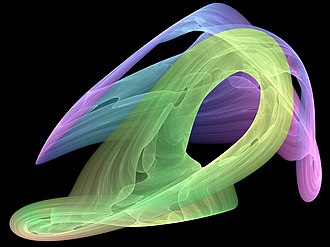Our website is made possible by displaying online advertisements to our visitors.
Please consider supporting us by disabling your ad blocker.
Attractor
This article includes a list of general references, but it lacks sufficient corresponding inline citations. (March 2013) |
This article needs additional or more specific categories. (December 2024) |

In the mathematical field of dynamical systems, an attractor is a set of states toward which a system tends to evolve,[2] for a wide variety of starting conditions of the system. System values that get close enough to the attractor values remain close even if slightly disturbed.
In finite-dimensional systems, the evolving variable may be represented algebraically as an n-dimensional vector. The attractor is a region in n-dimensional space. In physical systems, the n dimensions may be, for example, two or three positional coordinates for each of one or more physical entities; in economic systems, they may be separate variables such as the inflation rate and the unemployment rate.[not verified in body]
If the evolving variable is two- or three-dimensional, the attractor of the dynamic process can be represented geometrically in two or three dimensions, (as for example in the three-dimensional case depicted to the right). An attractor can be a point, a finite set of points, a curve, a manifold, or even a complicated set with a fractal structure known as a strange attractor (see strange attractor below). If the variable is a scalar, the attractor is a subset of the real number line. Describing the attractors of chaotic dynamical systems has been one of the achievements of chaos theory.
A trajectory of the dynamical system in the attractor does not have to satisfy any special constraints except for remaining on the attractor, forward in time. The trajectory may be periodic or chaotic. If a set of points is periodic or chaotic, but the flow in the neighborhood is away from the set, the set is not an attractor, but instead is called a repeller (or repellor).
- ^ Desprez, Nicolas. "Chaoscope > Gallery". www.chaoscope.org. Archived from the original on 30 September 2023. Retrieved 21 December 2024.
- ^ Weisstein, Eric W. "Attractor". MathWorld. Retrieved 30 May 2021.
Previous Page Next Page


